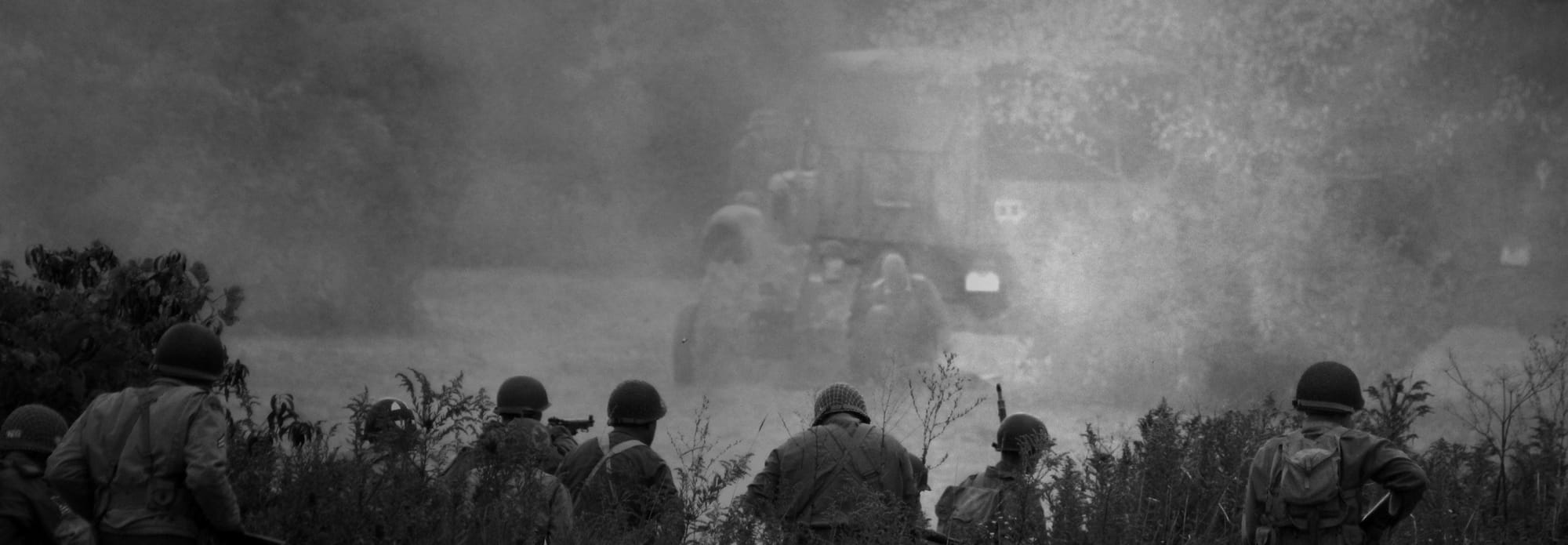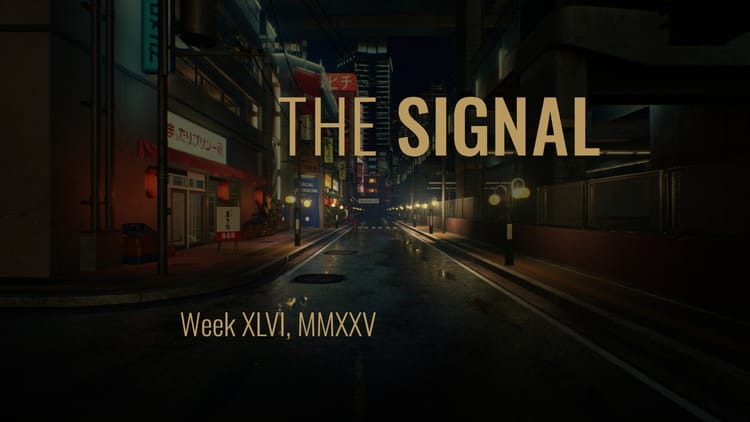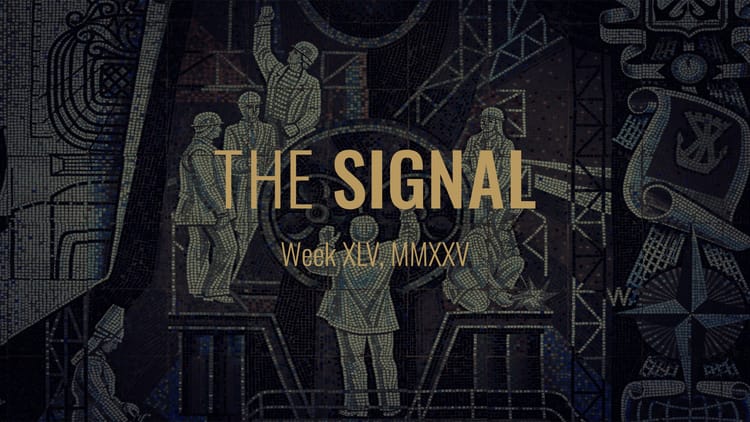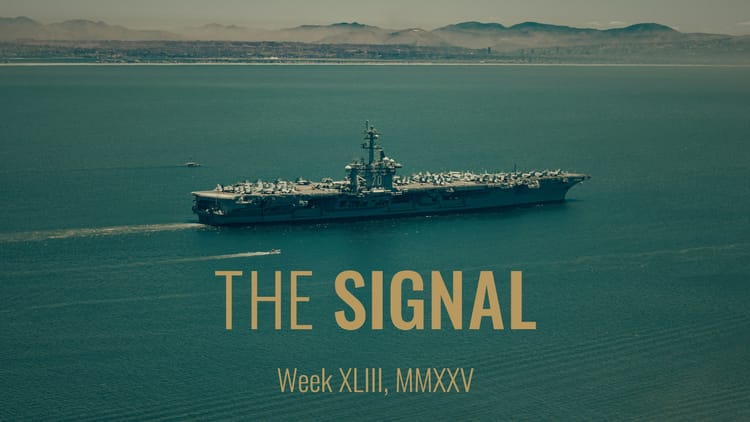The end of World War II is over

This week
- Ukraine’s ultimatum: six days to accept territorial concessions or lose U.S. support. Russian drones violate NATO airspace. The last U.S.-Russia nuclear arms treaty expires in 75 days, and no one’s negotiating a replacement. Now what?
- How much does North Korea depend on China and Russia for its future? Rachel Minyoung Lee on nuclear weapons, technology transfers, and a newly emboldened Kim Jong Un.
- Why are investors down on artificial intelligence? Daron Acemoglu on excesses of enthusiasm, returns on investment, and the distinctive nature of human reasoning.
Weather report
- The polar vortex collapses over the north. Peak-summer hits the south.
+ Cultural intelligence
- What’s plunderphonics?
- & The week in new music

Developments
What’s happening? November 15-21.
144 hours
On Wednesday, the U.S. administration delivered a 28-point peace plan to Ukraine with a message and a deadline. President Volodymyr Zelenskyy had until Thanksgiving—six days—to accept terms that would cede Ukrainian territory to Russia, limit the size of Ukraine’s military, and bar the country from NATO membership. If he refused, Ukraine risked losing American support. “You’re going to have to like it,” President Donald Trump told reporters when asked about Zelenskyy’s response.
The plan itself reads like a diplomatic artifact from another era. The United States would recognize Russia’s control of Crimea and the Donbas “de facto.” Ukraine would withdraw from parts of Donetsk it still holds, creating a demilitarized buffer zone. A “Peace Council” chaired by Trump would monitor compliance. The United States drafted the entire framework exclusively with Russian input. No one consulted European allies.
Watch what happened to produce this moment. Trump began his second presidency in January by threatening Russia with “further sanctions and high tariffs” if President Vladimir Putin refused to negotiate. By May, he was publicly accusing Putin of spreading “bullshit.” In July, he announced a major deal to send Patriot air defense batteries to Ukraine and threatened Russia with new sanctions. In August, he hosted Putin in Alaska—without inviting Zelenskyy—and discussed territorial concessions. In October, he declared that Ukraine “can win all of Ukraine back in its original form.” Now, Ukraine gets the ultimatum.
What’s happening?
- The old world is gone. The pressure works because no institutional framework prevents it. For 80 years, the architecture built after World War II operated on a premise: Great powers don’t simply dictate terms to smaller states without some constraint from international law, treaty obligations, or multilateral process. The United Nations Security Council existed to prevent this kind of bargaining over a third country’s territory. NATO’s Article 5 existed to make aggression unthinkable. Arms control treaties prevented unconstrained nuclear competition. Those mechanisms aren’t functioning anymore.
- Bilateral channels replace multilateral process. The Ukraine peace plan bypasses the UN Security Council entirely. Negotiations happen in U.S.-Russia channels, with European allies learning terms from news reports. The plan resembles territorial settlements the post-1945 order was built to prevent—borders changed by force, smaller nations treated as spheres of influence rather than sovereign states. Russia and the United States drafted the framework together. Ukraine got six days to respond.
- Treaties expire without replacement. New START, the last remaining nuclear arms control treaty between the United States and Russia, expires February 5, 2026—75 days from now. No replacement is in negotiation. Putin proposed in September that both sides voluntarily observe the treaty’s limits for one year beyond expiration. Trump called it “a good idea” but made no formal response. The treaty will simply lapse, leaving both powers free to expand their nuclear arsenals for the first time in decades.
- Alliances prepare for failure. At June’s NATO summit in The Hague, the alliance committed to spending 5 percent of GDP on defense by 2035—up from 2 percent. This wasn’t because deterrence was working. It was because deterrence was visibly failing. The alliance had to prepare for a world where American security guarantees might be conditional, where Article 5 might not mean what it meant for 75 years.
- Mechanisms exist on paper but don’t constrain. In September, Poland invoked NATO’s Article 4 consultation mechanism after Russian drones violated Polish airspace during attacks on Ukraine. The consultations allow allies to discuss threats without triggering Article 5’s collective defense provision. NATO held the consultations but took no further action. Russian drone and missile fragments have continued to land in Polish and Romanian territory. The mechanisms exist. They just don’t constrain behavior anymore.
- Pressure finds whoever responds. Trump’s oscillation reveals something about negotiations without institutional constraints. Without treaties or multilateral processes creating costs for certain actions, you pressure whoever responds to pressure. Russia doesn’t respond—Putin escalates attacks, makes maximalist demands, uses negotiations to consolidate gains. So pressure shifts to Ukraine, which does respond because it depends on American support. Each time Trump pressures Russia and meets resistance, he pivots to Ukraine. Each time he pressures Ukraine and European allies object, he temporarily reverses. The negotiations become ultimatums directed at whichever party seems most likely to move.
- Built by people who remembered. The institutional arrangements preventing this dynamic were built by people who remembered industrial-scale war. They remembered what happened when great powers pursued spheres of influence, when borders could be redrawn by force, when arms races spiraled without constraint. The architecture wasn’t perfect—it failed to prevent conflicts, allowed abuses, privileged powerful nations. But it operated on a shared understanding that certain forms of great power behavior were too dangerous to permit. The last major Western leader who commanded troops in World War II, George H.W. Bush, left office in 1993. The last Soviet leader who fought in that war, Mikhail Gorbachev, died in 2022. The generation that built the postwar order is gone.
Watch what this tests. What happens when the pattern exhausts itself? If Ukraine accepts terms under duress, what prevents Russia from using the same playbook against the next neighbor? If Ukraine refuses and loses American support, what does that mean for American commitments? If European nations step in, do they have the capacity to sustain Ukraine without American involvement?
By Friday, Zelenskyy had agreed to discuss the proposal but made clear what was at stake. “Ukraine may find itself facing a very difficult choice,” he said. “Either loss of dignity, or the risk of losing a key partner.” European leaders rallied behind him—France’s Emmanuel Macron, Britain’s Keir Starmer, and Germany’s Friedrich Merz insisted that current front lines must be the starting point for negotiations and that Ukraine’s military must retain defensive capacity. The plan, they said diplomatically, needs “additional work.”
The institutional memory of why these frameworks existed is fading along with the people who built them. The mechanisms are expiring—sometimes literally, as with New START, sometimes functionally, as with the UN Security Council’s role in territorial disputes. What’s replacing them isn’t clear yet. What is clear is that the substitutes are being stress-tested in real time, and the stresses are showing up in places like Kyiv, where a president has six days to choose between his country’s dignity and its most important security partner.
The armistice that started in 1945 lasted long enough that people stopped thinking of it as an armistice. But it was one. And it is. That phase is over.
Meanwhile
- A prosecution frays. A federal judge ordered the Justice Department to release all grand jury material in the James Comey prosecution, citing “profound investigative missteps” and “government misconduct.” Magistrate Judge William Fitzpatrick singled out interim U.S. attorney Lindsey Halligan—a former Trump personal attorney with no prosecutorial experience—for misstating the law to grand jurors. … Stakes: What happens when a Justice Department built for impartial law enforcement gets deployed for political revenge? … Since: The Justice Department acknowledged on Wednesday that a full grand jury never reviewed the final indictment against Comey. Prosecutors only presented it to the foreperson and one other grand juror. “There is no indictment Mr. Comey is facing,” his defense lawyer said. The statute of limitations has expired.





